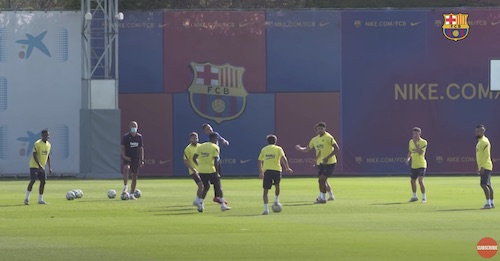Soccer drills and practice ideas: Here are five good soccer drills that you can run through at almost every soccer training session. These are drills that work on fundamental aspects of the game of soccer and that form the foundation of every good player. These are soccer skills that all players can work on, from defenders to forwards. If you’re looking for soccer training ideas, here are five great ones.
Each soccer drill touches on key elements of the game, from control to passing, to dribbling, to crossing and finishing. Let’s get started and get better. Let’s look at some of the soccer drills that top soccer teams in the world do every day, from Barcelona to Liverpool to Real Madrid.
Image credit for above picture to FC Barcelona.
Below are five soccer drills to work on to help you reach a higher level as a player. Figure out what soccer drills you actually enjoy doing and master those soccer drills with your team or on your own:
1) Dribbling and soccer skills work. Even at the highest level top soccer players work on their dribbling skills every day. It’s the old use it or lose it concept.
Moreover though, it’s about keeping your dribbling skills sharp, and specifically, the ability to cut and beat players on the dribble. If you watch someone like Messi or Cristiano Ronaldo, their ability to beat players comes down to working on their dribbling skills day in and day out. Yes, even these players do it everyday, and it’s because they love to play and only want to get better.
Start with a bit of juggling in pairs just to get warmed up. Players call out a 1, 2, or 3 and their partner then has to juggle that many times. Players can play the ball to their partner high in the air or right to their feet.
Then do some Coerver type of dribbling skills in a square, some turns and a few moves on the ball. Players should work on playing the ball with their weaker foot and doing new moves that they can add to their game. Again, even the best players have new turns or moves they can work on.
Next, to keep your players dribbling skills sharp, setup a shuttle run for players to dribble through. This could be a series of cones they dribble through, and then a section where they sprint with the ball, and finally a section where there’s a passive defender they have to beat with a move and maybe even take a shot on goal. The keys are making sure players touch the ball with every step when they take a step with the ball and then after they do their move, they explode past the defender. Change of pace is the key to beating a defender, so slow and then blow past the defender.
2) Control and touch on the soccer ball. This is a good warm-up drill and also good to do once at almost every session: In pairs about five yards away from one another, one player tosses the ball in the air to his or her teammate’s right and left inside of the foot, top of the foot, thigh, chest, and head. Go through the cycle about ten times each – ten times on the left inside of the foot, left instep, right inside of the foot, right instep, left thigh and inside of the foot, right thigh and instep, and so on.
Keep your ankle locked and hit the ball sharply back to your teammate’s hands. It helps to turn the body slightly to the side, so when you’re playing the ball with your right foot your body is turned towards the right. Don’t face your partner with your hips directly forward. Instead, shift your body to which ever side you are working on. Try not to stand still but bounce a bit on your feet or toes as if you’re playing in a game and looking to control the ball and make a pass.
3) Tight spaces under pressure. Keep away in a tight square, starting out without restrictions, and then go to two touch, and then one touch. Towards the end, make it a competition where the team who completes ten passes first wins. The ideas is to make this like a very congested space so it’s difficult for players to play out of. It’s those situations where the field is crowded and players have to play short passes to escape pressure. Really, this is a rondo soccer drill or keep away game in a small area.
For example, just when someone throws the ball into the feet of another player, the area is bound to be crowded. It requires the player to say play the ball back to the thrower who then plays the ball to the next player with tons of space. It’s those two or three passes before pressure can be broken.
Another good example is the Barcelona break pressure with a triangle setup in the middle, Iniesta, Xavi, and Busquets all play the ball back and forth to one another. They play the soccer ball to the player with the most time and space and they use one another almost like walls, as they play the ball and get it back when they’re more open.
4) Follow your pass rule soccer drill. (groups of three) This is a good warm-up drill as well as good for improving and maintaining your technique. Remember to always play crisp and sharp passes. You can set this up at various distances to work on both short and long passes.
Start out ten to twenty yards apart and simply pass the ball to your teammate who then passes the ball to the next player in a rotation; you get a good warm-up by following your pass. Start this drill using only two touches and then move on to one touch. Have the player who is making the initial pass close down the player who is receiving the pass, acting like a defender – force the player to go one direction. Make them control the ball to one side or the other with just two touches, one for control and the other to make the pass. Make one clean touch to the side and then make the pass.
Next you can spread out to thirty or forty yards away and play the ball in the air, trying to maintain the rotation and sharpness of the drill with two touch play and driving the ball into your teammates. A lofted pass is easy for the defense to intercept and gives them time to close your teammate down. You can practice all types of passes – chips, bending the ball, half-volleys, and low driven balls.
5) Crossing and finishing soccer drills. It’s a good idea to finish a day of practice with some crossing and finishing. Have your defenders and midfielders serve the ball into the forwards who make near and far post runs.
When doing a crossing drill or any drill, try not to hit a ball that is still. Have a teammate play the ball into the players who are crossing the ball – either a crisp pass into their feet or play a ball ahead of them. It’s not a game-like situation if the ball is dead and not moving. The next player in line plays the ball to the person who is crossing the ball. Use a crisp pass to start the play.
Forwards trying to score line up at the top of the box – making near and far post runs, midfielders and defenders out wide. Crossers of the ball should try to pick a player out with the cross, not just send the ball in blindly. Rotate the crossers and the finishers after ten crosses.
Those trying to score should take one touch to score, perhaps two touches sometimes, but rarely ever will a player in the box have time to get a good shot off if they take more than two touches. The exception would be if they pull off a move, like a fake shot and then cut the ball to the other foot to shoot. And, the idea with a cross is to simply redirect the ball, not control the ball and then shoot. So, scorers shoot be ready to fire the ball into the net when making their near and far post runs into the box.
What if the crosser cuts the ball back and takes a few additional touches to get the ball into the box? That’s when the players making their runs rotate positions, meaning the player at the near post spins away and makes a far post run and the player at the far post makes a run to the near post. All players should be prepared to make adjustments in the game based upon what their teammates are doing on the field.
Learning how your teammates play and move and dribble will come after playing together in training. But overall the game of soccer is simple, and players should know when to cross the ball or cut the ball back, there are just certain touches or moves that player will learn that their teammates like to do and then they can expect this. Players will learn to read and anticipate what their teammates are going to do when they make certain movements and touches.
Check out these soccer training sessions for other positions:















